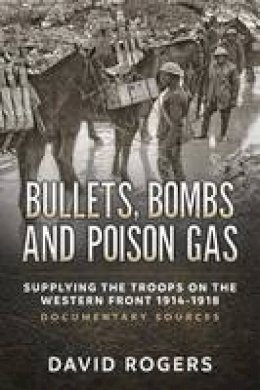23%OFF

Stock image for illustration purposes only - book cover, edition or condition may vary.
Bullets, Bombs and Poison Gas: Supplying the Troops on the Western Front 1914-1918, Documentary Sources
David Rogers
€ 25.99
€ 20.11
FREE Delivery in Ireland
Description for Bullets, Bombs and Poison Gas: Supplying the Troops on the Western Front 1914-1918, Documentary Sources
Paperback. Num Pages: 240 pages, 32 colour ills, 39 tables. BIC Classification: 1DBK; 3JJF; HBJD1; HBLW; HBWN; JWT. Category: (P) Professional & Vocational. .
Soldiers in the trenches were issued with four bullets a day unless they were either snipers or manned a machine gun. This does not seem like a lot of bullets. However, four bullets a day is 28 per week. Therefore a million soldiers need 28 million bullets per week. Of course there were a lot more than a million troops at the Western Front, so the number of required bullets was more than that! I realise that some of the soldiers performed vital service functions and some were busy on other duties, nevertheless there was a need for a lot of bullets. Supplying the troops was further complicated by the need to ensure that the many and varied shells were available for the howitzers, mortars and other artillery. Furthermore, there was a need for essential supplies of a whole manner of other materials, including rations for the troops and food for the many horses. Aircraft and tanks also started to make an appearance on the battlefield at this time which required supplies. Indeed there is one account of a horse drawn cart carrying aircraft fuel to the aeroplanes! The move to modern technology must have been interesting to watch. The static nature of battle was somewhat unique in the annals of warfare and led to the use of a narrow gauge railway network and a roll on roll off ferry port in Kent to speed deliveries along. Unfortunately, not all of the traffic was towards the trenches. Sadly there were many casualties who needed to return to the hospitals either in the field or back in Britain. The returning trains performed this vital function. Servicing this supply chain was a complex business, leading to some interesting issues.
Product Details
Publisher
Helion & Company
Format
Paperback
Publication date
2017
Condition
New
Weight
28g
Number of Pages
304
Place of Publication
Solihull, United Kingdom
ISBN
9781911512080
SKU
V9781911512080
Shipping Time
Usually ships in 4 to 8 working days
Ref
99-3
About David Rogers
David Rogers is a scientist by training, obtaining a doctorate in chemistry before working for a Fellow of the Royal Society for his post-doctorate. He went on to spend many years in British industry working for a multi-national company in both research and manufacturing departments inventing, developing or helping to manufacture a range of products. He is a Fellow of the Royal Society of Chemistry, The Royal Photographic Society and of the British Institute of Professional Photography. He was a Visiting Professor in Business Psychology for three years and is now a Visiting Lecturer. He decided to transition to a career involving writing, consultancy and some teaching in 2004. Since that time, David has written or edited eight published books, mainly in the field of science/technology or wartime history. Married with two children, David has spent some of his spare time as a School Governor.
Reviews for Bullets, Bombs and Poison Gas: Supplying the Troops on the Western Front 1914-1918, Documentary Sources
A fascinating look at the logistics of weapons and ammunition supply during the Great War...
Books Monthly
An incredibly interesting and important book.
WW1 Revisited
The author looks at a mass of mind-boggling statistics, but in a way which is readable and informative. A fascinating book.
Britain at War Magazine
Books Monthly
An incredibly interesting and important book.
WW1 Revisited
The author looks at a mass of mind-boggling statistics, but in a way which is readable and informative. A fascinating book.
Britain at War Magazine
